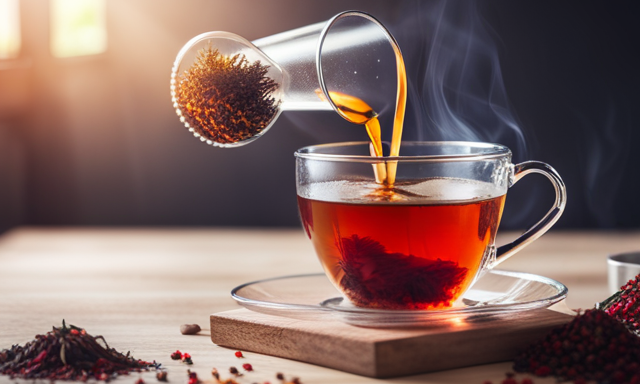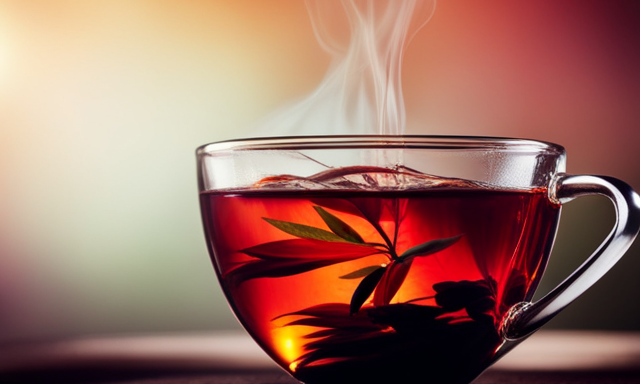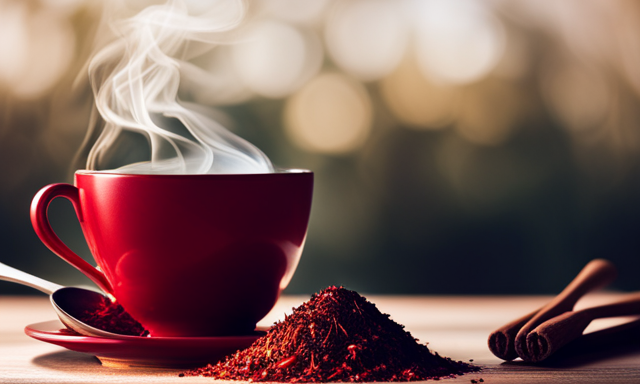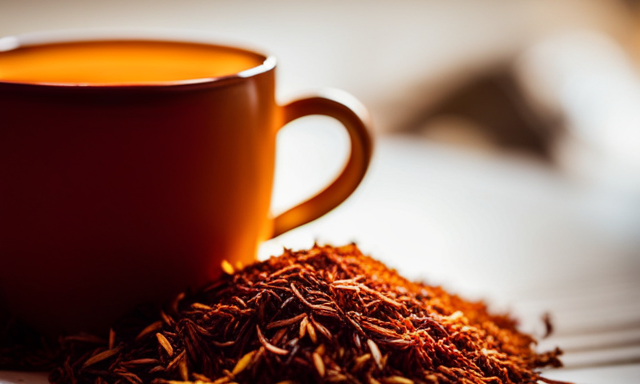When it comes to brewing the perfect cup of rooibos tea, I’ve got you covered.
Picture this: the comforting aroma of warm tea leaves fills the air as you eagerly prepare to indulge in a moment of relaxation.
Brewing rooibos tea is not only a delightful experience but also a journey into the rich history and health benefits of this South African herbal tea.
In this article, I’ll guide you through the process, step by step, ensuring that you achieve the impeccable brew you desire.
From selecting the finest rooibos tea leaves to enhancing its flavor with a touch of sweetness, I’ll share my knowledge and expertise to help you create a cup of rooibos tea that is both satisfying and nourishing.
So, let’s embark on this tea-brewing adventure together and discover the wonders of rooibos tea.
Key Takeaways
- Enhancing the brewing process with beautifully crafted teapot and delicate tea infuser
- Creating a peaceful environment with dimmed lights, calming music, and cozy atmosphere
- Incorporating relaxation techniques such as deep breathing and meditation
- Finding a quiet spot to enjoy the tea and savor each sip
Understanding the Origins of Rooibos Tea
To truly appreciate the rich and unique flavor of rooibos tea, you should delve into the fascinating origins of this South African herbal infusion.
The origins of rooibos cultivation can be traced back to the indigenous Khoisan people who’ve been using the leaves of the Aspalathus linearis plant for centuries. The Khoisan recognized the medicinal properties of rooibos and used it to treat various ailments.
It wasn’t until the 20th century that rooibos tea gained popularity outside of Africa. Today, it holds cultural significance in South Africa and is enjoyed for its earthy and slightly sweet taste.
Now, let’s move on to the next section about choosing the right rooibos tea leaves and preparing the perfect brew.
Choosing the Right Rooibos Tea Leaves
When selecting the perfect leaves, you’ll want to envision a warm, inviting cup of pure indulgence. Choosing the best quality rooibos tea is crucial to achieving that desired taste.
There are different varieties of rooibos tea to consider, each with its own unique flavor profile. Here are four key factors to keep in mind when choosing your rooibos tea leaves:
- Look for leaves that are vibrant in color and have a fresh aroma.
- Opt for organic and sustainably sourced tea leaves to ensure the highest quality.
- Consider the type of rooibos tea you prefer, whether it’s green rooibos, red rooibos, or a flavored blend.
- Pay attention to the grade of the leaves, with higher grades often indicating better quality and flavor.
Understanding these aspects will help you make an informed decision when selecting your rooibos tea leaves.
Now that we’ve chosen the perfect leaves, let’s move on to preparing your tea equipment.
Preparing Your Tea Equipment
Get ready to indulge in a warm, inviting cup of pure bliss by preparing your tea equipment just right.
The first step is choosing the right tea infuser, which’ll ensure that the delicate flavors of the rooibos tea leaves are fully extracted. Look for an infuser with fine mesh, as this’ll prevent any loose tea leaves from escaping into your cup.
Next, prepare your teapot by rinsing it with hot water to warm it up and remove any residual flavors. This’ll create the perfect environment for brewing your rooibos tea.
Now that your tea equipment’s ready, it’s time to move on to the next step: boiling water to the optimal temperature.
Boiling Water to the Optimal Temperature
Now is the time to achieve the perfect cup of tea by bringing your water to its optimal temperature. Boiling techniques play a crucial role in extracting the delicate flavors of rooibos tea. It’s important to use fresh, cold water and bring it to a rolling boil.
The water temperature is of utmost importance as it affects the taste and aroma of the tea. For rooibos tea, the optimal temperature is around 200°F (93°C). To achieve this, bring the water to a boil and then let it cool for a minute before adding it to your tea leaves. This slight drop in temperature ensures that the tea brews at its best.
With the water at the perfect temperature, it’s time to move on to adding the rooibos tea leaves to your infuser or teapot.
Adding the Rooibos Tea Leaves to Your Infuser or Teapot
To truly enhance your tea experience, imagine the satisfaction as you delicately place the vibrant rooibos leaves into your infuser or teapot, letting their rich aroma envelop your senses.
When it comes to choosing between a teapot and an infuser, it ultimately depends on personal preference. If you’re brewing for a larger group, a teapot may be more suitable, as it can hold a greater quantity of water and tea leaves. However, if you prefer a single cup or want to easily control the strength of your tea, an infuser is the way to go.
When adding the leaves, make sure not to overcrowd the infuser or teapot, as this can hinder the steeping process.
Now that your leaves are in place, it’s time to move on to the next crucial step: allowing the tea to steep for the perfect amount of time.
Allowing the Tea to Steep for the Perfect Amount of Time
As you wait for the flavors to meld and the colors to transform, the anticipation builds, creating a sense of excitement and curiosity. Steeping techniques play a crucial role in achieving the perfect cup of rooibos tea. The longer you allow the tea to steep, the stronger and more robust the flavor becomes. Steeping time can vary depending on personal preference, but generally, steeping rooibos tea for 5-7 minutes produces a well-balanced cup. However, if you prefer a stronger brew, feel free to extend the steeping time to 8-10 minutes. The benefits of longer steeping time include a richer taste and enhanced health benefits, as the tea leaves release more antioxidants and polyphenols. Once the steeping time is complete, it’s time to strain the tea to remove the leaves, ensuring a smooth and enjoyable drinking experience.
Straining the Tea to Remove the Leaves
Once the anticipation of the steeping process has built up, it’s time for you to strain the tea, allowing the vibrant colors and flavorful essence to flow freely and create a visually captivating experience.
Straining the tea is an important step that ensures a smooth and enjoyable drinking experience. To strain the tea effectively, consider the following options:
- Using a fine mesh strainer: This allows you to remove the leaves while keeping the tea’s rich color intact.
- Utilizing a tea infuser: This handy tool keeps the leaves contained, making it easy to remove them and avoid any unwanted bits in your cup.
- Trying cheesecloth or a coffee filter: These alternatives are great for removing excess water and capturing any fine particles.
By removing the leaves and excess water through straining, you’ll be left with a delightful and pure rooibos tea.
Now, let’s explore how to enhance its flavor in the next section.
Enhancing the Flavor of Your Rooibos Tea
Unleash the full potential of your cup by discovering simple ways to enhance the tantalizing flavor of your rooibos tea. Enhancing the flavor of your rooibos tea can be a delightful experiment that allows you to customize your brew to your taste preferences.
One way to enhance the flavor is by adding a touch of sweetness with honey or a sprinkle of cinnamon for a warm and comforting taste. Another option is to infuse your tea with fresh fruits like lemon or orange slices, giving it a refreshing citrus twist.
For a more indulgent treat, you can even try adding a splash of milk or a dollop of cream for a creamier texture. By experimenting with different rooibos tea recipes, you can create a unique flavor profile that suits your personal preferences.
Now let’s delve into the health benefits of rooibos tea.
Discovering the Health Benefits of Rooibos Tea
Now that we’ve explored ways to enhance the flavor of your rooibos tea, let’s delve into the health benefits that this delightful beverage offers.
Rooibos tea is known for its antioxidant properties, which can help protect your cells from damage caused by free radicals. Additionally, studies have shown that rooibos tea may have potential anti-inflammatory effects, which can be beneficial for those dealing with chronic inflammation.
So, why not sip on a cup of rooibos tea and let its natural goodness work its magic on your body? It’s time to sit back, relax, and enjoy the soothing effects of this incredible tea.
In the next section, we’ll discuss how to fully enjoy your cup of rooibos tea in peace and relaxation.
Enjoying Your Cup of Rooibos Tea in Peace and Relaxation
Indulge in the tranquility of savoring a steaming cup of this exquisite beverage, allowing its soothing qualities to wash away the stresses of the day. Creating a calming tea ritual can enhance the experience of enjoying your cup of Rooibos tea. Start by finding the best relaxation techniques that work for you. Some popular options include deep breathing exercises, meditation, or simply finding a quiet spot to sit and unwind. Set the mood by dimming the lights and playing soft, calming music. As you prepare your tea, take your time and enjoy the process. Use a beautifully crafted teapot and a delicate tea infuser to brew your Rooibos tea to perfection. While waiting for it to steep, take a moment to appreciate the aroma and the anticipation of the flavors to come. Finally, find a cozy spot to sit and savor each sip, allowing the warmth and taste of the tea to envelop you in a state of pure relaxation.
| Relaxation Technique | Benefits | Tips |
|---|---|---|
| Deep Breathing Exercises | Reduces stress and anxiety | Inhale deeply through your nose, hold for a few seconds, and exhale slowly through your mouth. Repeat several times. |
| Meditation | Increases mindfulness and promotes relaxation | Find a comfortable position, close your eyes, and focus on your breath. Let go of any thoughts or distractions. |
| Quiet Spot | Provides a peaceful environment | Find a room or outdoor space where you can be alone and free from distractions. Create a cozy atmosphere with soft lighting and comfortable seating. |
Frequently Asked Questions
Can I use any type of water to brew rooibos tea?
Absolutely! The type of water you use can greatly impact the taste of rooibos tea. Just like a conductor shapes an orchestra’s sound, different water qualities enhance or detract from the tea’s flavor profile.
How do I know if I have chosen the right temperature for boiling the water?
To determine if the water temperature is right for brewing rooibos tea, I use a thermometer to ensure accuracy. The ideal temperature is around 200°F (93°C), which brings out the best flavors without scorching the leaves.
Is it necessary to use an infuser or teapot to brew rooibos tea?
Using an infuser or teapot for brewing rooibos tea is not necessary, but it can enhance the flavor and convenience. An infuser allows the tea leaves to expand fully, while a teapot ensures even steeping.
Can I reuse the rooibos tea leaves for a second infusion?
Yes, you can reuse rooibos tea leaves for a second infusion. This not only extends the life of the tea but also enhances the flavor and benefits. The second infusion yields a milder yet still satisfying cup of tea.
How should I store my leftover brewed rooibos tea?
To store leftover brewed rooibos tea and prevent tea oxidation, I recommend transferring it to an airtight container and refrigerating it. This will help maintain its freshness and flavor for up to 48 hours.
Conclusion
In conclusion, brewing a perfect cup of rooibos tea is a delightful experience that can transport you to the beautiful mountains of South Africa. As you sip on this aromatic and flavorful beverage, you’re not only indulging in a moment of relaxation but also benefiting from its numerous health properties.
Did you know that rooibos tea is naturally caffeine-free and packed with antioxidants? Studies have shown that it can help lower blood pressure and reduce the risk of heart disease.
So, next time you crave a warm and soothing drink, reach for a cup of rooibos tea and enjoy its many benefits.










